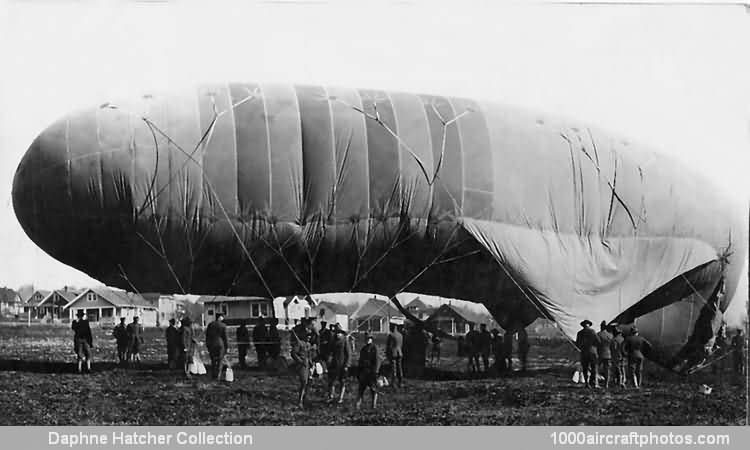Postcards from Sergeant Paul Roehr, ca. 1917-18
Paul Roehr, grandfather of Daphne Hatcher, was a Sergeant serving in the 6th Balloon Company of the American Expeditionary Force and sent his family postcards of the balloons he worked with.
On the back of the postcard pictured above he wrote: "This is a close up view of Goodyear type kite balloon No. 24 US Army. This type of balloon we use almost daily for practice purposes. It holds (not legible) cu. ft of hydrogen gas and carries two passengers."
On the back of
this postcard he wrote: "Goodyear type captive balloon and portable hangar or shed. A Company manning the ropes. Note me on right front rope with coil of rope in my hands. The man near the middle is our captain, the only man wearing a coat."
On the back of
this postcard he wrote: "This is a Goodyear type balloon, it has a gas capacity of 25,000 cu. ft. It is held captive by a 1/4 inch cable and can be sent up to a height of 6000 ft. and is used only for observation purposes."
In 1913 Ralph Upson won the International Balloon Race for the eighth Gordon Bennett Cup and was to also prevail in the National Balloon Races of 1913, 1919 and 1921. Upson was employed with the Goodyear Tire & Rubber Company, both as a balloon pilot and as chief engineer of the aeronautical department.
Upson held several captive balloon patents, including one for the cup-tail stabilizing appendage. The actual
US patent for the apparatus was applied for on June 20, 1916. Issued on July 26, 1921. Upson left Goodyear in the early 1920s to pursue an alternate vision for lighter-than-air design with the Aircraft Development Corporation.
02/28/2010. Remarks by Rod Filan: The postcards are photographs taken at Fort Omaha Balloon School, Nebraska in 1917 or 1918. All balloon school activities of the US Army Signal Corps had been transferred to Fort Omaha in 1905. In 1907 the Army built a large steel hangar at Fort Omaha for use in experiments with dirigibles, a program that was abandoned in 1909.
This program and its successor were part of the American Expeditionary Forces. A balloon house was built in 1908, and in 1909 the first balloon flight took place. The military acquired additional space for training called Florence Field, at the corner of North 30th and Martin Streets in North Omaha. The Balloon School shut down in 1913, then re-started in 1916.
The first classes at the Balloon School began in June 1917 with the Upson Kite Balloon, manufactured by Goodyear, arriving shortly after. Upson's design was not a great success and was found to have poor handling characteristics and the tailcups were clumsy to manage. The first Type R captive balloon, the Caquot-copy by Goodyear, reached Omaha on October 22, 1918, and very soon, the old kites would be abandoned.
Shortly after the United States entered World War I in 1917, 800 men immediately enlisted in the US Army Signal Corps. They were sent to the Fort Omaha Balloon School for training. They later provided forward observations for the artillery. More than 16,000 airmen went through the Balloon School.
After a time the Army determined that weather conditions at Fort Omaha were not suitable for rapidly training balloon companies. In 1918 a contingent of officers and men from Fort Omaha were assigned to Camp John Wise in Texas. The Balloon School at Fort Omaha was soon ended.

